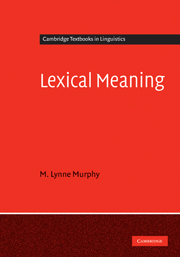Book contents
- Frontmatter
- Contents
- List of figures
- Preface: using this book
- Acknowledgments
- Typographical conventions
- Part I Meaning and the lexicon
- 1 The lexicon – some preliminaries
- 2 What do we mean by meaning?
- 3 Components and prototypes
- 4 Modern componential approaches – and some alternatives
- Part II Relations among words and senses
- Part III Word classes and semantic types
- References
- Index
3 - Components and prototypes
from Part I - Meaning and the lexicon
Published online by Cambridge University Press: 05 June 2012
- Frontmatter
- Contents
- List of figures
- Preface: using this book
- Acknowledgments
- Typographical conventions
- Part I Meaning and the lexicon
- 1 The lexicon – some preliminaries
- 2 What do we mean by meaning?
- 3 Components and prototypes
- 4 Modern componential approaches – and some alternatives
- Part II Relations among words and senses
- Part III Word classes and semantic types
- References
- Index
Summary
Key words:
component, classical theory, definition, encyclopedic information, decomposition, necessary and suff icient conditions, semantic feature, semantic primitive, redundancy rules, prototype
Overview
This chapter introduces componential approaches to meaning and some of the more serious challenges to such approaches. In componential approaches, word senses are built out of constituent parts – that is, word senses are complexes of simpler meaning components. One type of componential approach is the Classical Theory of meaning, which defines words on the basis of necessary and sufficient conditions. After looking at general properties of classical componential approaches, we turn to Katz's groundbreaking work in the classical style from the 1960s and 1970s. Then we examine some psychological evidence about the nature of meanings – that senses have “fuzzy boundaries” and display “prototype effects.” This kind of evidence invalidates the classical notion that all senses are based strictly on necessary and sufficient conditions. Yet as we see in chapter 4, other componential approaches have risen to these challenges. This chapter provides some of the vocabulary that we need for discussing the more contemporary theories.
- Type
- Chapter
- Information
- Lexical Meaning , pp. 43 - 57Publisher: Cambridge University PressPrint publication year: 2010



